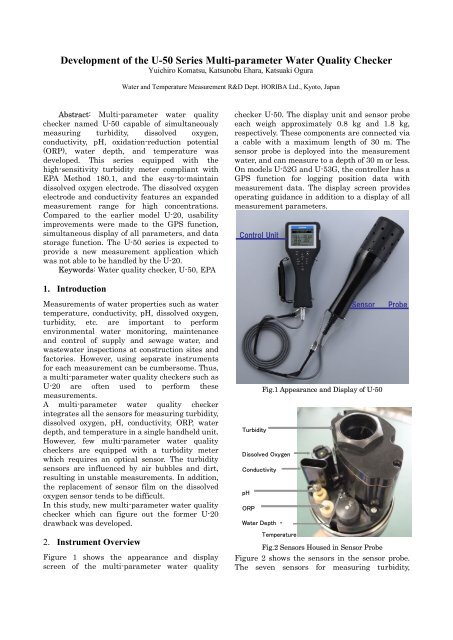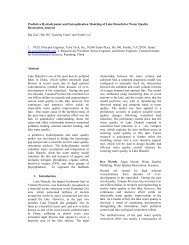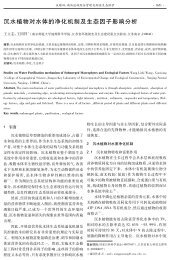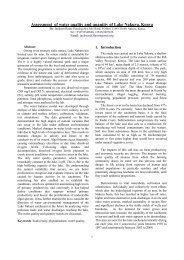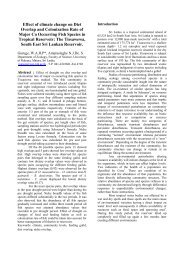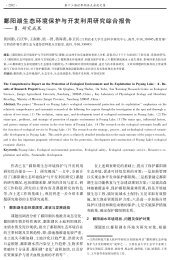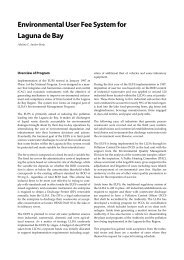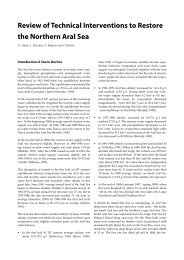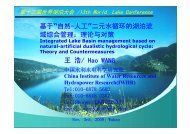Development of the U-50 Series Multi-parameter Water Quality ...
Development of the U-50 Series Multi-parameter Water Quality ...
Development of the U-50 Series Multi-parameter Water Quality ...
Create successful ePaper yourself
Turn your PDF publications into a flip-book with our unique Google optimized e-Paper software.
<strong>Development</strong> <strong>of</strong> <strong>the</strong> U-<strong>50</strong> <strong>Series</strong> <strong>Multi</strong>-<strong>parameter</strong> <strong>Water</strong> <strong>Quality</strong> CheckerYuichiro Komatsu, Katsunobu Ehara, Katsuaki Ogura<strong>Water</strong> and Temperature Measurement R&D Dept. HORIBA Ltd., Kyoto, JapanAbstract: <strong>Multi</strong>-<strong>parameter</strong> water qualitychecker named U-<strong>50</strong> capable <strong>of</strong> simultaneouslymeasuring turbidity, dissolved oxygen,conductivity, pH, oxidation-reduction potential(ORP), water depth, and temperature wasdeveloped. This series equipped with <strong>the</strong>high-sensitivity turbidity meter compliant withEPA Method 180.1, and <strong>the</strong> easy-to-maintaindissolved oxygen electrode. The dissolved oxygenelectrode and conductivity features an expandedmeasurement range for high concentrations.Compared to <strong>the</strong> earlier model U-20, usabilityimprovements were made to <strong>the</strong> GPS function,simultaneous display <strong>of</strong> all <strong>parameter</strong>s, and datastorage function. The U-<strong>50</strong> series is expected toprovide a new measurement application whichwas not able to be handled by <strong>the</strong> U-20.Keywords: <strong>Water</strong> quality checker, U-<strong>50</strong>, EPAchecker U-<strong>50</strong>. The display unit and sensor probeeach weigh approximately 0.8 kg and 1.8 kg,respectively. These components are connected viaa cable with a maximum length <strong>of</strong> 30 m. Thesensor probe is deployed into <strong>the</strong> measurementwater, and can measure to a depth <strong>of</strong> 30 m or less.On models U-52G and U-53G, <strong>the</strong> controller has aGPS function for logging position data withmeasurement data. The display screen providesoperating guidance in addition to a display <strong>of</strong> allmeasurement <strong>parameter</strong>s.Control Unit1. IntroductionMeasurements <strong>of</strong> water properties such as watertemperature, conductivity, pH, dissolved oxygen,turbidity, etc. are important to performenvironmental water monitoring, maintenanceand control <strong>of</strong> supply and sewage water, andwastewater inspections at construction sites andfactories. However, using separate instrumentsfor each measurement can be cumbersome. Thus,a multi-<strong>parameter</strong> water quality checkers such asU-20 are <strong>of</strong>ten used to perform <strong>the</strong>semeasurements.A multi-<strong>parameter</strong> water quality checkerintegrates all <strong>the</strong> sensors for measuring turbidity,dissolved oxygen, pH, conductivity, ORP, waterdepth, and temperature in a single handheld unit.However, few multi-<strong>parameter</strong> water qualitycheckers are equipped with a turbidity meterwhich requires an optical sensor. The turbiditysensors are influenced by air bubbles and dirt,resulting in unstable measurements. In addition,<strong>the</strong> replacement <strong>of</strong> sensor film on <strong>the</strong> dissolvedoxygen sensor tends to be difficult.In this study, new multi-<strong>parameter</strong> water qualitychecker which can figure out <strong>the</strong> former U-20drawback was developed.2. Instrument OverviewFigure 1 shows <strong>the</strong> appearance and displayscreen <strong>of</strong> <strong>the</strong> multi-<strong>parameter</strong> water qualityTurbiditySensorFig.1 Appearance and Display <strong>of</strong> U-<strong>50</strong>Dissolved OxygenConductivitypHORP<strong>Water</strong> Depth ・TemperatureProbeFig.2 Sensors Housed in Sensor ProbeFigure 2 shows <strong>the</strong> sensors in <strong>the</strong> sensor probe.The seven sensors for measuring turbidity,
dissolved oxygen (DO), pH, conductivity, ORP,water depth, and temperature is embedded into10-cm diameter probe base. The sensors forturbidity, DO, pH, and ORP are removable andeasy to replace.Membrane Cap3. Comparison <strong>of</strong> <strong>the</strong> U-20 and U-<strong>50</strong>Table 1 compares <strong>the</strong> specifications <strong>of</strong> <strong>the</strong> U-20and newly developed U-<strong>50</strong> series. As shown in <strong>the</strong>table, improvements were also made to eachmeasurement <strong>parameter</strong>. Significantimprovements were made particularly in <strong>the</strong>turbidity meter and dissolved oxygen electrode.The turbidity meter in <strong>the</strong> U-20 uses an LED as<strong>the</strong> light source with a 30 degree scatteringmethod. Meanwhile, <strong>the</strong> U-<strong>50</strong> series model U-53uses a tungsten lamp as <strong>the</strong> light source with a 90degree scattering method. This method complieswith <strong>the</strong> US EPA Method 180.1, and is strongagainst chromaticity differences while beinghighly sensitive to small particles. Prior to <strong>the</strong>measurement, <strong>the</strong> wiper can clean <strong>the</strong> sensorwindow to reduce <strong>the</strong> influences <strong>of</strong> air bubblesand dirt.The dissolved oxygen sensor on <strong>the</strong> U-<strong>50</strong> is basedon <strong>the</strong> polarographic method, whereas on <strong>the</strong>U-20 <strong>the</strong> galvanic battery system. This means <strong>the</strong>electrode can be lead-free, making it exempt <strong>of</strong>restrictions imposed by <strong>the</strong> European RoHSregulation. As shown in Figure 3, <strong>the</strong> oxygenisolation film is shaped like a cap. This allows <strong>the</strong>customer to replace <strong>the</strong> film simply by tightening<strong>the</strong> film cap. Additionally, <strong>the</strong> measurementrange was expanded.Table 2 shows potential new measuringapplications for <strong>the</strong> U-<strong>50</strong> series afforded by <strong>the</strong>seimprovements. The improved turbiditymeasuring accuracy enables measurement andcontrol <strong>of</strong> ground water, environmental water,and plant water with low turbidity. Turbiditysensors in previous multi-<strong>parameter</strong> waterquality checkers are not capable <strong>of</strong> measuring lowturbidity concentrations. Users who accustomedto measuring turbidity separately will appreciate<strong>the</strong> simplified and simultaneous measurement.The expanded measuring range for dissolvedoxygen enables measurement and control <strong>of</strong> highconcentrations <strong>of</strong> oxygenated water such asoxygen enriched drinking-water and <strong>the</strong>photosyn<strong>the</strong>tically-activated environment water.The expanded measuring range for conductivityenables measurement <strong>of</strong> high salinity samplessuch as seasonings solution in <strong>the</strong> food makingindustry.DO Sensor Main BodyFig.3 Structure <strong>of</strong> DO Sensor4. Measurement ExamplesThe changes in turbidity and dissolved oxygen asmeasured continuously over 12 days in Inba-pond,Chiba prefecture is shown in Figure 4. When webegan measuring on May 28, <strong>the</strong> turbidity was20.5 NTU and <strong>the</strong> COD value was 10.0 ppm. Theturbidity and COD value dropped during <strong>the</strong>measurement period and became 5.89 NTU and8.8 ppm, respectively, on <strong>the</strong> last day <strong>of</strong> June 9.This result suggests decrease in organic matter.The dissolved oxygen (DO) concentrationincreased from <strong>the</strong> morning to <strong>the</strong> afternoon, anddecreased from <strong>the</strong> evening to <strong>the</strong> followingmorning. This is <strong>the</strong> result <strong>of</strong> oxygen generated byphotosyn<strong>the</strong>sis in <strong>the</strong> afternoon, and oxygenconsumed by breathing during <strong>the</strong>night.Although traces <strong>of</strong> organic matter werefound on <strong>the</strong> measurement unit after 12 days <strong>of</strong>continuous measurement, <strong>the</strong> wiper kept <strong>the</strong> cellwindow on <strong>the</strong> turbidity meter in a clean state.
Tab.1 Specifications and Improved Points <strong>of</strong> U-20 andU-<strong>50</strong> <strong>Series</strong>Parts name Item U-20 <strong>Series</strong> U-<strong>50</strong> <strong>Series</strong> Improved PointsSensor Probe Measurement temperature 0~55℃ -5~55℃ Measurable low temperature sampleBacklightingLCDCustum(monochrome) Graphic LC(monochrome) <strong>Multi</strong>ple <strong>parameter</strong>s listed on Screen1 <strong>parameter</strong> listed on Screen 11 <strong>parameter</strong> listed on Screen Equipped with backlightingControl UnitMagnified view <strong>of</strong> display valueData memory 2880 100001 day's data acquisition at intervals <strong>of</strong> 10seconds通 信 RS232 USB (peripheral) speeding up <strong>of</strong> data movement to PCpHOxidationReducitonPotential(ORP)DissolvedOxygen(DO)Conductivity(COND)SalinityTotal DissolvedSolid(TDS)Seawaterspecific gravityσ t、σ 0、σ 15TemperatureTurbidity(TURB)<strong>Water</strong> DepthMeasurement principleRangeResolutionRepeatabilityAccuracyMeasurement principleRangeResolutionRepeatabilityAccuracyGlass electrode methodpH0 to 140.01pH±0.05pH±0.1pHPlatinum electrode method-2000mV to +2000mV1mV±5mV±15mVMeasurement principle Galvanic method Polarographic methodRange 0 to 19.99 mg/L 0 to <strong>50</strong>.00 mg/LResolutionRepeatabilityAccuracy0.2 mg/L0.01mg/L±0.1mg/L0~20 mg/L:±0.2mg/L20~<strong>50</strong> mg/L:±0.5mg/LMeasurement principleRange 0 to 9.99 S/m4 AC electrode method0 to 10 S/mResolutionRepeatability ±1 %F.S.0.1 %F.S.±0.5 %F.S.Accuracy ±3 %F.S. ±1 %F.S.Measurement principleConductivity coversionRange 0 to 4% 0 to 70 PPTResolutionRepeatabilityAccuracyMeasurement principleRangeResolutionRepeatabilityAccuracyMeasurement principleRangeResolutionRepeatabilityAccuracyMeasurement principleRange 0 to 55℃0.1PPT(0.01%)±1PPT(0.1%)±3PPT(0.3%)Conductivity coversion0 to 100 g/L0.1%F.S.±2 g/L±5 g/LConductivity coversion0 to <strong>50</strong> σt0.1σt±2 σt±5 σtThermistor method-5 to 55℃ResolutionRepeatability ±0.3℃0.01℃±0.1℃(at calibration point)Measurement principleLED light sourceTungsten lamp sourceScattering Method 90°scattering method (U-53)Range 0 to 800 NTU 0 to 1000 NTUResolution 0.1 NTU 0.01 NTURepeatability±3 %F.S.±3 %(Reading) orAccuracy±5 %F.S.Tab.2 New Applications Possible with <strong>the</strong> U-<strong>50</strong> <strong>Series</strong>Features <strong>of</strong> <strong>the</strong> U-<strong>50</strong>New applicationsImproved turbidity accuracy±0.1NTU whichever is greater0 to 10NTU:±0.5NTU10 to 1000NTU:±3 %(Reading) or±1NTU whichever is greaterMeasurement principlePressure methodRange 0 to 100m 0 to 30mResolution 0.1m 0.05mRepeatability ±3%F.S. ±1%F.S.Accuracy ±5%F.S. ±0.3mMeasurement and control <strong>of</strong> low turbidity ground water,environmental water, supply water, and plant water.Expanded measurement range for Control <strong>of</strong> high concentrations <strong>of</strong> oxygenated waterdissolved oxygen(beverages, envirionment water)Expanded measurement range for High salinity concentrations (seasonings, factory wastewater,conductivityetc.)Lowering running cost by chipping pH andReference SensorLowering running cost by chipping ORPSensorcalibration by ORP Standard SolutionSafety inner Solution (KCl solution)Easy maintenance by DO membrane CapLead-free componentmesurable saturated oxygen solutionAccuracy improvement by 4 pointcalibrationMeasurable doubled general seawaterSalinityRepeatability improvementThe wiper can clean <strong>the</strong> sensor window toreduce <strong>the</strong> influences <strong>of</strong> air bubbles and dirt.U-53 uses a tungsten lamp as <strong>the</strong> lightsource with a 90 degree scattering method.This method complies with <strong>the</strong> US EPAMethod 180.1.Accuracy improvement by New pressuresensor
Turbidity(NTU)<strong>50</strong>454035302520151055 月2824/172917/143014/123123/13TurbidityDO6 月121/17216/1<strong>50</strong>5/28 5/30 6/1 6/3Date6/5 6/7 6/9322/14Fig.4 Continuous Test Data <strong>of</strong> Turbidity and DO in424/17Lake ImbaFigure 5 shows <strong>the</strong> measurement results for pHand ORP. On sunny days during <strong>the</strong> continuoustesting period, <strong>the</strong> pH values shifted to alkaline.This result suggests that photosyn<strong>the</strong>sis <strong>of</strong> plantscaused <strong>the</strong> carbon dioxide gas and organic matterin <strong>the</strong> lake to drop. On <strong>the</strong> o<strong>the</strong>r hand, <strong>the</strong> ORPshifted to <strong>the</strong> reducing side, suggesting that <strong>the</strong>effects <strong>of</strong> water purification induced byphotosyn<strong>the</strong>sis.10.05 月2824/172917/143014/123123/136 月121/17216/15322/14424/17523/15523/15625/18625/18726/19726/19822/19822/19922/20922/20876543210<strong>50</strong>0DO(mg/L)immersion direction changed over a range <strong>of</strong> 0.0NTU to 1.0 NTU. Measuring in <strong>the</strong> retractiondirection from 20 m to 10 m showed a significantchange from 0.0 NTU to 5.0 NTU, revealing adiscrepancy with <strong>the</strong> measurement in <strong>the</strong>immersion direction. This suggests that airbubbles occurred on <strong>the</strong> measuring unit due todecompression and temperature rise. On <strong>the</strong>o<strong>the</strong>r hand, <strong>the</strong> U-53 turbidity meter, equippedwith a wiper, showed consistent results between0.3 NTU and 0.8 NTU, in both immersion andretraction directions. This result indicates that<strong>the</strong> wiper on <strong>the</strong> new turbidity meter effectivelycancels <strong>the</strong> effects <strong>of</strong> air bubbles.Turbidity(NTU)6543210Turbidity <strong>of</strong> U-53(Lower)Turbidity <strong>of</strong> U-20(Lower)Turbidity <strong>of</strong> U-53 (raised)Turbidity <strong>of</strong> U-20 (raised)0 10 20 30<strong>Water</strong> Depth(m)Fig.6 Turbidity immersion test in Lake MotosupH9.59.08.58.07.5pHORP4<strong>50</strong>4003<strong>50</strong>3002<strong>50</strong>2001<strong>50</strong>ORP(mg/l)5. ConclusionThe newly developed U-<strong>50</strong> features EPAMethod 180.1 compliant turbidity sensor,expanded measurement ranges and greaterease <strong>of</strong> handling. These features can expand<strong>the</strong> scope <strong>of</strong> an existing multi-<strong>parameter</strong> waterquality checker.7.05/28 5/30 6/1 6/3 6/5 6/7 6/9Date100Fig.5 Continuous Test Data <strong>of</strong> pH and ORP in LakeImbaFigure 6 shows <strong>the</strong> results <strong>of</strong> measurements inMotosu Lake, Yamanashi prefecture. In thismeasurement, <strong>the</strong> same test was performed using<strong>the</strong> turbidity meter on <strong>the</strong> former model U-20(30-degree transmission scattering method),which does not have a wiper. On <strong>the</strong> U-20turbidity meter, <strong>the</strong> measurement in <strong>the</strong>


